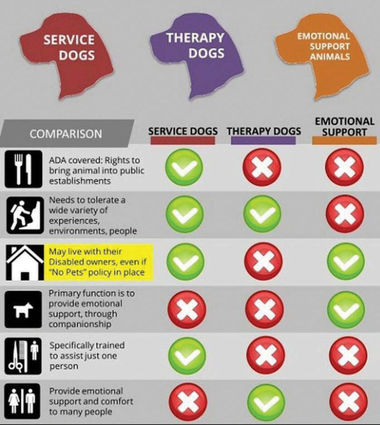Are the unclear service dog guidelines hurting those they were made to protect?
We seem to see service animals everywhere we go these days but how many of these animals actually went through the arduous process that being a true service dog requires? According to cci.org, the Canine Companions For Independence website, each of their service dogs spends the first two years of their life in training before being assigned to the person they will assist. This training costs them nearly $50,000 per dog. This is what Melissa Billingsley's service dog Hiltie had to go through before being able to proudly wear that vest.
Hiltie's work allows Melissa, a Tehachapi resident and veterinary technician, a freedom that wouldn't be possible without her. Hiltie is trained to constantly be listening for different sounds such as alarms, ringtones, knocking at the door, and her owner's name. When she hears a sound, she alerts her owner by nudging her with her nose then goes on to bring Melissa to the origin of the sound. However there has been a recent spike in the number of people simply buying a vest and putting it on their dog, so they can bring them into places like restaurants or the grocery store.
There are places online that people have been visiting to purchase vests and what looks like an official ID tag, but these IDs are no more official than a mail-in PhD. All one has to do is go online to one of the many websites, and purchase a vest and ID tag and now their dog is suddenly a "service animal". These dogs however have had little to no training and some aren't even housebroken.
Purchasing a fake vest online falsifies a service dog and can harm people who are disabled and require a service dog to function independently in society. According to Melissa, her dog has been attacked before by one of these "service dogs". She had been in the store when suddenly this other "service dog" jumped out of its owner's arms and ran to attack Hiltie. There was nothing Hiltie could do but just sit there because she was specifically trained never to attack anything, just as this other dog should have been. There have been stories like this popping up all over the country yet still the problem continues. The ADA stipulates that a service dog must be in control at all times, not barking, lunging or wandering. If a handler does not take action to control their misbehaving dog, a business has the right to ask that the dog be removed, although the customer must still be served without the dog present.

Melissa Billingsley
This infographic explains the differences but also illustrates why there is confussion.
The problem lies with the fact that the service dog laws are heavily ambiguous. Most people that I talked to seem to feel there needs to be a change within the system to create a registry for all service dogs that requires proof of training before assigning an official ID. Not only that but business owners need to know what they can and can't do in the case someone enters their store with a service dog. According to the ADA, Americans with Disabilities Act, there are only two questions staff may ask: "Is the dog a service animal required because of a disability?" and "What work or task has the dog been trained to perform?" They go on to specifically state that business staff cannot ask about the person's disability or require any form of identification to prove the dog has been trained. The service dog guidelines have created loopholes that people have used to be able to take their dog into public places not realizing the legitimate reasons why an untrained dog should not be allowed. These vague laws and loopholes that people have found have caused many problems for business owners and the disabled people they were originally meant to protect. To learn more about service dogs you can visit the Canine Companions for Independence website at cci.org, or visit the Guide Dogs of America page at guidedogsofamerica.org.
Emotional support dogs and therapy dogs have no public access. Also, a service dog only has access with the person who requires a dog. If a service dog is not behaving in a professional manner, i.e., barks, acts badly or goes to the bathroom, the business owner has every right to ask the dog to be removed.
For more information on where service animals are allowed visit adata.org/publication/service-animals-booklet.




